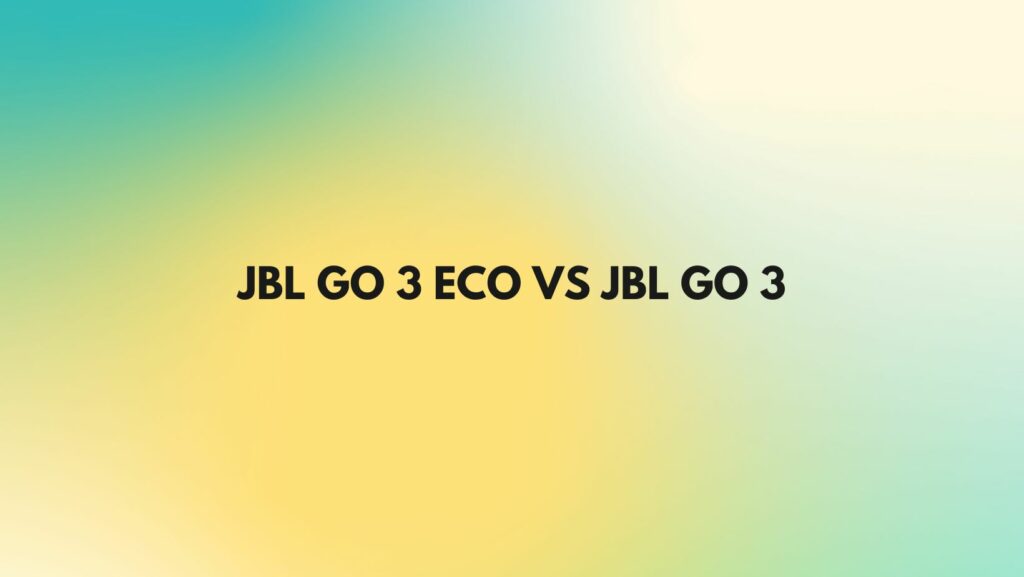JBL, a pioneer in the audio industry, continues to evolve its lineup of compact and portable speakers, catering to users who crave powerful sound on the go. The JBL Go 3 and JBL Go 3 Eco stand out as siblings in the JBL family, offering users an immersive audio experience with a nod to sustainability. In this detailed comparison, we’ll explore the design, sound quality, eco-friendly features, and additional functionalities of the JBL Go 3 and JBL Go 3 Eco, helping you make an informed choice for your portable audio needs.
Design and Portability:
The JBL Go 3 and Go 3 Eco share a similar design DNA, emphasizing a compact and sleek form factor. The Go 3 Eco, however, introduces an eco-friendly twist with its exterior fabric made from 90% recycled plastic bottles. Both speakers are designed to be ultra-portable, featuring a rectangular shape that fits easily into pockets or bags. The Go 3 Eco maintains the same portability and convenience of the Go 3, ensuring users can carry their music wherever they go.
Sound Quality:
Despite their small size, both the JBL Go 3 and Go 3 Eco are engineered to deliver impressive audio quality. Both models feature a full-range driver, aiming to provide a balanced sound profile with clear vocals and detailed highs. The focus on audio quality ensures that users can enjoy their favorite tunes with clarity and depth, regardless of the compact size of these portable speakers.
Eco-Friendly Features:
The standout feature of the JBL Go 3 Eco is its commitment to sustainability. The exterior fabric of the Go 3 Eco is made from 90% recycled plastic bottles, contributing to a reduction in environmental impact. This eco-conscious approach allows users to enjoy their music while making a positive choice for the planet. The standard Go 3, while not made from recycled materials, maintains a compact and energy-efficient design.
Durability and Water Resistance:
Both the JBL Go 3 and Go 3 Eco are designed to withstand the rigors of daily use, offering durability for users on the move. They share an IP67 rating, making them waterproof and dustproof. This level of protection ensures resilience against water splashes, making them suitable for various outdoor activities. Users can confidently take their speakers to the beach, poolside, or on hiking adventures without worrying about environmental elements.
Battery Life and Connectivity:
Portable speakers need to offer sufficient battery life for extended use, and seamless connectivity is essential. Both the JBL Go 3 and Go 3 Eco provide up to 5 hours of playtime on a single charge. This duration, while modest, is suitable for short outings and ensures that users can enjoy uninterrupted music on the go. Both models support Bluetooth connectivity, allowing for easy pairing with a variety of devices.
Additional Features:
The JBL Go 3 and Go 3 Eco share additional features that enhance the user experience. Both models include a built-in strap that adds an element of convenience for carrying or hanging the speaker. The strap design aligns with the portability aspect of these speakers, allowing users to effortlessly integrate them into their daily activities.
Conclusion:
Choosing between the JBL Go 3 and JBL Go 3 Eco ultimately depends on your specific needs and values. If you prioritize an eco-friendly design made from recycled materials without compromising on audio quality, the Go 3 Eco may be the ideal choice. On the other hand, if you are more focused on the compact and portable design while enjoying the signature JBL sound, the Go 3 remains a solid and reliable option. Consider your lifestyle, commitment to sustainability, and the features that matter most to you to make an informed decision and enjoy your portable audio experience guilt-free. Happy listening!

